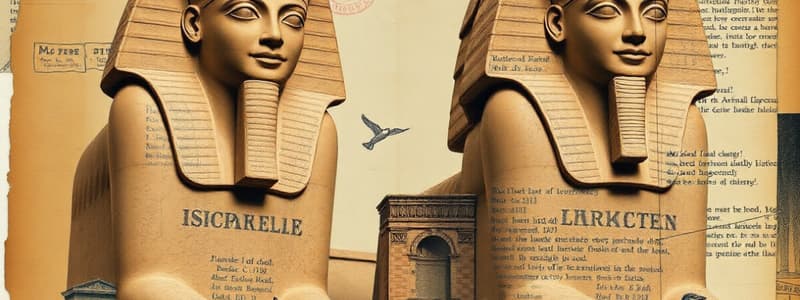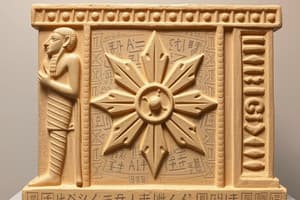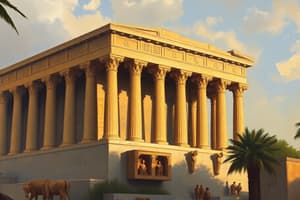Podcast
Questions and Answers
How does the artist emphasize the volume and roundness of the female form in the sculpture?
How does the artist emphasize the volume and roundness of the female form in the sculpture?
- By using bright colors to enhance visibility
- By applying a rough texture to the surface of the skin
- By exaggerating the proportions of the limbs
- By incorporating subtle indentations along the body's lines (correct)
What effect do the diagonal lines created by the draping across the torso have?
What effect do the diagonal lines created by the draping across the torso have?
- They emphasize the curves of the figure (correct)
- They create a chaotic appearance
- They draw the eye downwards along the body
- They obscure the curves of the figure
What aspect of the drapery contributes to the overall sense of movement in the sculpture?
What aspect of the drapery contributes to the overall sense of movement in the sculpture?
- The use of monochromatic color schemes
- The intricate patterns of the folds and pleats (correct)
- The rigid, straight lines of the fabric
- The lack of texture in the fabric
How does the texture of the fabric enhance the depiction of the human body?
How does the texture of the fabric enhance the depiction of the human body?
What does the design of the Narmer Palette symbolize?
What does the design of the Narmer Palette symbolize?
What does the reddish tone of the stone suggest about the sculpture?
What does the reddish tone of the stone suggest about the sculpture?
Which aspect of art is emphasized in the portrayal of figures on the Narmer Palette?
Which aspect of art is emphasized in the portrayal of figures on the Narmer Palette?
What was the primary function of the Narmer Palette in ancient Egyptian society?
What was the primary function of the Narmer Palette in ancient Egyptian society?
What significant architectural advancement is demonstrated by Djoser's funerary complex?
What significant architectural advancement is demonstrated by Djoser's funerary complex?
In what way did the Narmer Palette influence ancient Egyptian art?
In what way did the Narmer Palette influence ancient Egyptian art?
What does Djoser's funerary complex signify in relation to pharaonic power?
What does Djoser's funerary complex signify in relation to pharaonic power?
What type of cultural identity does the Narmer Palette represent?
What type of cultural identity does the Narmer Palette represent?
What aspect of Sesostris III's expression is emphasized in his portrayal?
What aspect of Sesostris III's expression is emphasized in his portrayal?
When was Djoser's funerary complex completed?
When was Djoser's funerary complex completed?
What does the pool surrounded by trees in Nebamun's tomb symbolize?
What does the pool surrounded by trees in Nebamun's tomb symbolize?
How does the artistic style of the Narmer Palette primarily differ from strict realism?
How does the artistic style of the Narmer Palette primarily differ from strict realism?
What does SMPV in the context of Nebamun's banquet scene refer to?
What does SMPV in the context of Nebamun's banquet scene refer to?
What role does the hierarchy of scale play in Egyptian art as seen in Nebamun's tomb?
What role does the hierarchy of scale play in Egyptian art as seen in Nebamun's tomb?
What is a notable feature of the naturalistic portrayal in Nebamun's tomb?
What is a notable feature of the naturalistic portrayal in Nebamun's tomb?
How does the portrayal of Sesostris III reinforce his authority?
How does the portrayal of Sesostris III reinforce his authority?
Which element is NOT a characteristic of the banqueting scene in Nebamun's tomb?
Which element is NOT a characteristic of the banqueting scene in Nebamun's tomb?
What period does the 3rd millennium encompass?
What period does the 3rd millennium encompass?
Which feature is NOT characteristic of the stylistic choices in Egyptian sculpture?
Which feature is NOT characteristic of the stylistic choices in Egyptian sculpture?
How long does a century last?
How long does a century last?
What does the term 'blocky/4-square' describe in Egyptian sculpture?
What does the term 'blocky/4-square' describe in Egyptian sculpture?
What is indicated by the stance of Mycerinus in his statue?
What is indicated by the stance of Mycerinus in his statue?
Which idea is suggested by the depiction of the queen beside Mycerinus?
Which idea is suggested by the depiction of the queen beside Mycerinus?
What material was primarily used to carve the statue of Chephren?
What material was primarily used to carve the statue of Chephren?
Which of the following is NOT one of the basic stylistic features of Egyptian sculpture?
Which of the following is NOT one of the basic stylistic features of Egyptian sculpture?
What feature signifies the actual presence of the divine in a temple?
What feature signifies the actual presence of the divine in a temple?
How does the pathway towards the sacred area of a temple typically change?
How does the pathway towards the sacred area of a temple typically change?
What is the significance of the geographical location of Hatshepsut's funerary complex?
What is the significance of the geographical location of Hatshepsut's funerary complex?
What is one of the primary functions of Hatshepsut's funerary complex?
What is one of the primary functions of Hatshepsut's funerary complex?
Which architectural feature enhances the visitor experience in Hatshepsut's complex?
Which architectural feature enhances the visitor experience in Hatshepsut's complex?
What does the agglomerate character of a temple suggest?
What does the agglomerate character of a temple suggest?
What aspect does the temple represent when described as a microcosm?
What aspect does the temple represent when described as a microcosm?
Why was Hatshepsut's funerary complex built?
Why was Hatshepsut's funerary complex built?
Flashcards are hidden until you start studying
Study Notes
Drapery and Body Emphasis
- High waist design highlights and emphasizes the breasts, enhancing female form.
- Large navel and flesh folds accentuate the belly area, drawing attention to the pubic triangle.
- Thigh lines converge towards the pubic area, creating an intimate focal point.
- Subtle indentations carved into the fabric suggest weight and pressure, adding realism and highlighting curves.
- The fabric clings closely to the body, revealing contours of breasts, stomach, and hips.
- Contrasting textures: smooth skin juxtaposes with the rough, striated fabric, enhancing tactile qualities.
- Drapery creates intricate patterns, adding movement and dynamism across the figure.
- Diagonal lines in drapery lead the viewer’s eye upward, emphasizing the figure's curves.
- Deep, rich stone color contrasts with the implied smoothness of flesh, suggesting warmth and texture.
Narmer Palette
- Depicts the unification of Upper and Lower Egypt under Narmer, symbolizing the First Dynasty.
- Features carvings that reinforce the pharaoh's divine authority, including symbols like the cobra and falcon.
- Artistic style characterized by low relief, showcasing skill and tradition in Egyptian artistry.
- Represents early dynastic period and establishment of a centralized Egyptian state.
- Influenced artistic conventions in ancient Egypt, marking a significant evolution in sculpture and representation.
Djoser’s Funerary Complex
- First large-scale stone structure in Egypt, marking a shift in royal burial practices.
- Completed around 2650 BCE, symbolizes the transition to refined pyramid architecture.
- Displays the importance of the afterlife and the pharaoh's power in ancient Egyptian culture.
Statue of Sesostris III
- Portrayed with serious, contemplative expression reflecting the burdens of rulership.
- Demeanor suggests authority and a connection to the divine, presenting him as a mediator between gods and people.
Tomb of Nebamun (Pool Scene)
- Features a pool surrounded by trees, symbolizing paradise and abundance.
- Naturalistic landscape portrayal reflects artistic advancements and the significance of nature in the afterlife.
- Scene shown from multiple viewpoints, enhancing visual narrative.
Tomb of Nebamun (Banqueting Scene)
- Idealized representation evokes abundance and tranquility, prioritizing artistic stylization over strict realism.
- Hierarchy of scale emphasizes significance; larger fish symbolize bounty in Nebamun’s afterlife.
- Top register depicts banquet while the bottom shows musicians and dancers, capturing the vibrant afterlife atmosphere.
Stylistic Features of Egyptian Sculpture
- Statues are frontally oriented with flat planes and minimal movement, emphasizing stability.
- Mass and blocky forms create an imposing presence, while figures demonstrate idealized proportions.
- Features are simplified and stylized, lacking realistic anatomy to emphasize permanence and monumentality.
Statue of Mycerinus and His Wife
- Mycerinus depicted in a striding pose, conveying authority and action.
- Queen's more static pose symbolizes support and stability, reflecting gender roles in ancient Egyptian representation.
Chephren (Khafre) Statue
- Carved from diorite to signify durability; idealized proportions reflect strength.
- Sits in a commanding pose, hands on knees, reinforcing the idea of the pharaoh's power and stability.
Temple Architecture
- Represents a microcosm of the world, designed for ritualistic and processional purposes.
- Interiors transition from public to sacred, with decreasing size, light, and increased spiritual significance.
- The temple's structure and layout serve to connect with the heavens and reflect ancient beliefs.
Hatshepsut’s Funerary Complex
- Located at Deir el-Bahari, symbolizing geographical and cultural significance tied to the sun god Amun-Ra.
- Multi-tiered architectural design harmonizes with natural landscape, enhancing visitor experience.
- Functions as a barque station for Amun-Re, a mortuary temple, and a complex dedicated to multiple gods.
- Built to commemorate Hatshepsut's legacy and secure her historical place as a pharaoh.
Studying That Suits You
Use AI to generate personalized quizzes and flashcards to suit your learning preferences.




